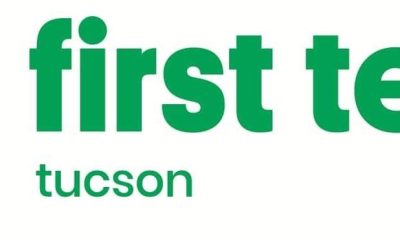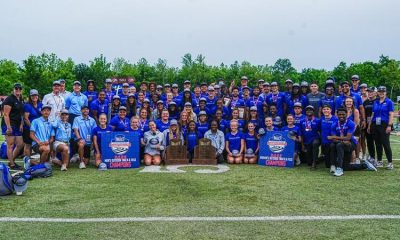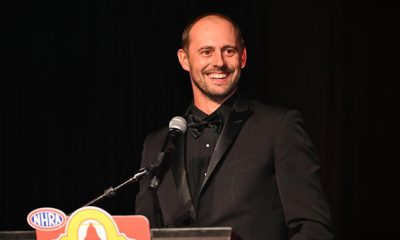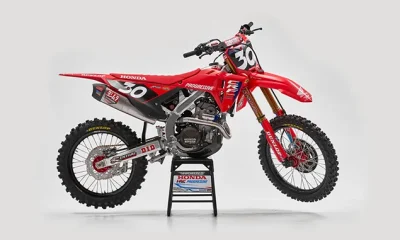Technology
I’m a health tech expert and these are the Memorial Day deals I recommend scooping up

- Current price: $200
- Original price: $250
The nice thing about buying one of Oura’s earlier model smart rings is you’ll get the same app and software experience — just a different form factor and one less day of battery life. If prospective Oura Ring buyers don’t mind this, they should opt for the Oura Ring 3, which has reduced its price by around 20% since the Oura Ring 4’s debut.
The Oura Ring tracks your daily sleep, stress, activity, and readiness to deliver scores, insights, and recommendations. It’s a great health tracker for people looking to optimize their sleep and activity routine, but who want gentle recommendations and encouragements that won’t make them feel bad about a poor night of sleep or a day of low activity. It’s constantly innovating with new features, like a Cardiovascular Age feature that tells you if your physiological age is ahead, behind, or at your chronological age. Plus, it partners with other health brands, like Dexcom, so you can keep track of your glucose levels on the Oura app if you use its Stelo continuous glucose monitor.
The smart ring is compatible with Android and iOS phones, so everybody can use it to capture data. The only downside of an Oura Ring is its $70 annual subscription (which is not on sale) to unlock all that data it collects and displays. The Ring Gen 3 is also an sale in select finishes and sizes at Oura.
Technology
All Winners List for The Game Awards 2025 Revealed

The Game Awards 2025 concluded on December 11 in Los Angeles, celebrating a standout year in gaming. The ceremony unveiled the full All Winners List across major categories, including Game of the Year, Best Art Direction, Best Narrative, and more. Fans tuned in worldwide to see whether Clair Obscur Expedition 33, Death Stranding 2 On the Beach, or Donkey Kong Bananza would claim top honors.
This year delivered an unusually competitive field. Nearly every major genre saw multiple critically acclaimed releases. The All Winners List highlights how diverse the gaming landscape has become, rewarding innovation, storytelling, performance, and design. Below is the complete breakdown of winners as confirmed during the live show.
Full All Winners List for The Game Awards 2025
The Game Awards recognized excellence across more than 30 categories. The All Winners List below reflects the official results announced during the broadcast. These selections were made through a combination of jury voting and fan participation. Trusted outlets such as Reuters and AP covered the event throughout the week, citing its global impact on the entertainment industry.
The ceremony featured wins for established franchises, emerging studios, and standout indie titles. Clair Obscur Expedition 33 dominated several major categories, cementing its status as one of the year’s most influential releases. Death Stranding 2 On the Beach and Hollow Knight Silksong also secured notable wins across art, music, and direction.


The winners list includes categories such as:
- Game of the Year
- Player’s Voice
- Best Game Direction
- Best Adaptation
- Best Narrative
- Best Art Direction
- Best Score and Music
- Best Audio Design
- Best Performance
- Innovation in Accessibility
- Games for Impact
- Best Ongoing Game
- Best Community Support
- Best Independent Game
- Best Debut Indie Game
- Best Mobile Game
- Best VR/AR Game
- Best Action Game
- Best Action/Adventure Game
- Best RPG
- Best Fighting Game
- Best Family Game
- Best Sim/Strategy Game
- Best Sports/Racing Game
- Best Multiplayer Game
- Most Anticipated Game
- Content Creator of the Year
- Best Esports Game
- Best Esports Athlete
- Best Esports Team
Each winner reflects the shifting trends of interactive entertainment. Publishers invested heavily in cinematic storytelling, AI-driven mechanics, and world-building. Indie studios saw renewed recognition, demonstrating how smaller teams continue to push creative boundaries.
How the 2025 All Winners List Shapes the Industry
The impact of the All Winners List extends far beyond the ceremony. Industry analysts note that Game Awards recognition often boosts sales, renews franchise momentum, and influences publisher strategies for the following year. Reuters reported that award-winning titles typically experience a significant rise in global downloads after the show’s conclusion.
For indie creators, nominations and wins can accelerate distribution partnerships and platform support. For major studios, standout wins in categories such as Game Direction or Narrative reinforce creative leadership and help guide long-term development pipelines.
The All Winners List also redirects attention toward emerging technologies showcased in nominated titles. VR advancements, accessibility innovations, and audio engineering breakthroughs from this year’s winners are expected to shape next-generation game design approaches.
The Game Awards 2025 All Winners List underscores how far the medium has evolved. It highlights a year defined by risk-taking, creativity, and boundary-pushing design. Fans now look ahead to 2026 as studios aim to build on the momentum created by this remarkable lineup of winners.
FYI (keeping you in the loop)-
Q1: What is included in The Game Awards 2025 All Winners List?
The list includes winners across more than 30 categories, covering major genres and industry achievements. Categories range from Game of the Year to Best Esports Team.
Q2: Which game won the most awards in 2025?
Clair Obscur Expedition 33 earned multiple major category wins, reflecting strong critical and fan support.
Q3: Why is The Game Awards All Winners List important?
The list influences sales trends, industry recognition, and future project investment decisions. It sets expectations for upcoming releases.
Q4: How are winners selected for The Game Awards?
A combined jury and public voting system determines winners. Both professional critics and global players contribute.
Q5: Does winning an award impact game development studios?
Recognition often leads to increased funding, hiring, and platform visibility. It can also validate creative direction for future titles.
iNews covers the latest and most impactful stories across
entertainment,
business,
sports,
politics, and
technology,
from AI breakthroughs to major global developments. Stay updated with the trends shaping our world. For news tips, editorial feedback, or professional inquiries, please email us at
[email protected].
Get the latest news and Breaking News first by following us on
Google News,
Twitter,
Facebook,
Telegram
, and subscribe to our
YouTube channel.
Technology
Gaming PC Market to Expand at 7.29% CAGR Through 2035 Driven


Gaming PC Market is witnessing rapid expansion as gaming evolves into one of the largest and most impactful segments of the digital entertainment industry. According to Market Research Future (MRFR), the Gaming PC Market Size was valued at USD 46.98 billion in 2024. The Gaming PC industry is projected to grow from USD 50.41 billion in 2025 to USD 101.9 billion by 2035, exhibiting a strong and consistent compound annual growth rate (CAGR) of 7.29% during the forecast period from 2025 to 2035.
The rise of high-performance gaming hardware, increasing popularity of competitive gaming, and strong global demand for immersive entertainment experiences are major factors supporting market growth. Gaming PCs are now central to professional eSports, casual gaming, and content creation, making the industry a key driver of technological innovation.
Market Drivers Fueling the Growth of the Gaming PC Market
One of the primary drivers accelerating the Gaming PC Market is the explosive rise of the global eSports ecosystem. Millions of players participate in online competitions, and large-scale tournaments attract global audiences. Professional gamers demand high-performance PCs capable of delivering maximum responsiveness, minimal lag, and high frame rates, directly boosting the need for advanced gaming systems.
Another critical driver is rapid GPU and CPU innovation. Leading hardware manufacturers continue to develop powerful processors and graphics cards equipped with next-generation capabilities such as ray tracing, AI-enhanced rendering, and ultra-fast clock speeds. These innovations significantly elevate gaming experiences and motivate both casual gamers and professionals to upgrade their systems.
The increasing popularity of open-world, high-resolution, and graphically demanding games is further boosting Gaming PC adoption. Modern titles require advanced hardware to support realistic visuals and immersive gameplay, pushing consumers toward high-end gaming PCs.
The rise of game streaming and content creation is also contributing to market expansion. Platforms such as Twitch, YouTube Gaming, and Facebook Gaming are encouraging gamers to produce high-quality content. This requires powerful systems that support streaming, recording, editing, and gameplay simultaneously.
Customization and personalization trends are shaping consumer behavior as well. Gamers increasingly prefer custom-built PCs with RGB lighting, advanced cooling solutions, and modular components. This trend is creating new opportunities for manufacturers, retailers, and PC assembly services globally.
Get An Exclusive Sample of the Research Report at – https://www.marketresearchfuture.com/sample_request/26477
Key Market Trends Shaping the Gaming PC Market
The Gaming PC Market is being reshaped by a number of powerful trends. One of the most significant is the integration of artificial intelligence into gaming hardware. AI-driven optimization tools help maximize performance, regulate cooling, enhance frame rates, and adjust settings in real time.
Another major trend is the growing dominance of high-performance gaming laptops. With advancements in thermal engineering and GPU performance, gaming laptops now offer nearly desktop-level power. This trend supports gamers who value flexibility and portability without sacrificing performance.
High-refresh-rate monitors are becoming standard among gamers. Demand for 144Hz, 240Hz, and even 360Hz displays is rising as gamers seek smoother animation and higher responsiveness, driving the need for PCs capable of supporting these advanced displays.
Liquid cooling systems are also gaining popularity. As gaming hardware becomes more powerful, maintaining safe temperatures is essential. Gamers increasingly adopt closed-loop and custom-loop liquid cooling systems to ensure long-term stability and performance.
Sustainable and energy-efficient gaming solutions are emerging as a new trend. Manufacturers are focusing on recyclable components, environmentally friendly production processes, and energy-efficient power supplies. This aligns with global sustainability awareness and appeals to environmentally conscious gamers.
Buy Now Immediate Delivery Available at – https://www.marketresearchfuture.com/checkout?currency=one_user-USD&report_id=26477
Regional Analysis of the Gaming PC Market
North America currently dominates the Gaming PC Market, supported by a large base of professional gamers, robust digital infrastructure, and widespread adoption of high-performance gaming systems. The United States remains a global leader in gaming hardware development and eSports investment.
Europe holds a significant share of the market as well. Countries such as Germany, France, and the United Kingdom have strong gaming cultures, extensive PC gaming communities, and widespread interest in competitive gaming. Government recognition of eSports as an official sport in certain regions has further strengthened market demand.
The Asia-Pacific region is poised for the highest growth rate during the forecast period. Nations such as China, South Korea, Japan, and India are expanding rapidly in the gaming ecosystem. China leads the region with millions of active gamers and strong investment in gaming arenas, esports stadiums, and internet cafés. South Korea remains a global pioneer in professional gaming and eSports.
Latin America is also witnessing rising Gaming PC adoption. Countries such as Brazil, Mexico, and Argentina are experiencing increasing interest in professional gaming and streaming, supported by improved internet connectivity and the establishment of local gaming events.
In the Middle East and Africa, gaming is expanding as younger populations adopt digital entertainment. Countries such as the UAE and Saudi Arabia are investing heavily in eSports infrastructure, creating new opportunities for Gaming PC manufacturers.
Challenges and Constraints in the Gaming PC Market
Despite strong growth potential, the Gaming PC Market faces several challenges. One major constraint is the high cost of components such as GPUs, CPUs, and high-performance RAM. Price fluctuations and supply shortages often discourage consumers from purchasing or upgrading gaming PCs.
Another challenge is the global supply chain volatility that affects semiconductor manufacturing. Limited chip availability during periods of high demand can delay product releases and reduce availability in key markets.
Energy consumption and heat generation are significant constraints as well. High-performance systems require efficient cooling solutions, and inadequate thermal management can impact performance and hardware longevity.
The rapid pace of technological change can also be a barrier for consumers. Frequent hardware upgrades may be required to support the latest games, making ownership costly for budget-conscious gamers.
Cybersecurity concerns surrounding online gaming and digital downloads pose additional challenges. Gamers are at risk of malware attacks, hacking, and data breaches, making security software an essential component of gaming setups.
Opportunities Driving Future Growth of the Gaming PC Market
Despite challenges, the Gaming PC Market offers vast opportunities. The expansion of VR and AR gaming is creating strong demand for powerful gaming PCs capable of supporting immersive experiences. As VR titles grow more sophisticated, hardware requirements will increase, benefiting the Gaming PC industry.
Cloud-connected gaming PCs present another major opportunity. Hybrid gaming systems that combine traditional hardware with cloud-based rendering can enhance performance and enable cost-effective upgrades.
The rise of gaming-focused social platforms is opening opportunities for PC manufacturers and accessories companies. Integrated ecosystems that support gaming, streaming, editing, and social interaction are becoming increasingly popular.
Emerging markets present strong potential for future expansion. Countries in Southeast Asia, the Middle East, Eastern Europe, and Africa are witnessing fast-growing gaming communities and rising disposable incomes, driving demand for affordable gaming PCs.
The growing support for STEM education and gaming-related careers such as game development, animation, and broadcasting is also fueling market demand. Students and professionals require powerful machines that deliver both gaming and productivity performance.
Explore the In-Depth Report Overview – https://www.marketresearchfuture.com/reports/gaming-pc-market-26477
The Gaming PC Market is set for robust expansion as global demand for high-performance gaming systems continues to rise. With a projected CAGR of 7.29% through 2035, the industry will benefit from technological innovation, eSports growth, immersive gaming trends, and rising participation in global gaming communities. Gaming PCs are becoming more advanced, more customizable, and more accessible, making them essential tools for gamers, streamers, content creators, and digital professionals alike. As hardware manufacturers push boundaries and gaming culture expands worldwide, the Gaming PC Market will remain a powerful driver of digital entertainment and global technological development.
About Market Research Future:
At Market Research Future (MRFR), we enable our customers to unravel the complexity of various industries through our Cooked Research Report (CRR), Half-Cooked Research Reports (HCRR), Raw Research Reports (3R), Continuous-Feed Research (CFR), and Market Research & Consulting Services.
MRFR team have supreme objective to provide the optimum quality market research and intelligence services to our clients. Our market research studies by products, services, technologies, applications, end users, and market players for global, regional, and country level market segments, enable our clients to see more, know more, and do more, which help to answer all their most important questions.
Contact Us:
Market Research Future (Part of Wantstats Research and Media Private Limited)
99 Hudson Street, 5Th Floor
New York, NY 10013
United States of America
+1 628 258 0071 (US)
+44 2035 002 764 (UK)
Email: sales@marketresearchfuture.com
Website: https://www.marketresearchfuture.com
This release was published on openPR.
Technology
Revived Retro Handheld Games : Ayaneo Pocket Play

A mobile-class processor powers the unit and includes 16 GB of RAM and up to 1 TB of internal storage. A dual-fan assembly and heat pipe design provide cooling. Battery capacity supports several hours of sustained gameplay, depending on the title and settings. Wireless connectivity includes Wi-Fi 6 and Bluetooth 5.2.
Image Credit: AYANEO
Technology
SA Gaming confirms presence at ICE Barcelona 2026 with showcase of premium live casino solutions

ICE Barcelona, which gathers more than 600 solution providers and an estimated 55,000 global gaming professionals, continues to serve as a critical hub for business expansion, technological innovation and international networking.
For SA Gaming, the event represents a prime opportunity to demonstrate its advances in live casino technology while strengthening its commercial footprint across Europe and beyond.
“We are excited to join ICE Barcelona 2026 and share our newest developments directly with operators and industry partners,” the company said. “The event provides the perfect setting to present our innovations and build strategic partnerships that can fuel long-term growth.”
Visitors to Stand 1E50 will have the opportunity to experience firsthand SA Gaming’s latest platform updates, table game enhancements and interactive live dealer features designed to increase player engagement and operational efficiency.
Event Details
Dates: January 19–21, 2026
Location: Fira Barcelona Gran Via, Barcelona, Spain
Stand: 1E50
SA Gaming is also inviting operators, partners and prospective clients to schedule dedicated meetings with its team during the three-day event. Those interested can secure an appointment through the company’s booking link.
As the countdown to ICE Barcelona 2026 begins, SA Gaming positions itself among the top exhibitors preparing to shape the future of live casino technology on one of the industry’s most prominent stages.
SA Gaming
SA Gaming is a leading Live Game Solution provider offering premium online entertainment for more than 15 years. Making use of state-of-the-art technology, it offers a full spectrum of Live Games including Baccarat, Roulette, Blackjack and many more.
The company has a Supplier License and an RGS Approval from the Ministry of Foreign Trade and Tourism of Peru (MINCETUR) and a B2B License from the Curacao Gaming Control Board (GCB). Every product is developed by professionals with diligence, and comes with trustworthy support services.
SA Gaming’s products are very popular among players around the world. Winner of the “Best Live Casino Provider” at SiGMA Asia Awards, “Best Live Dealer Solution” at Asia Gaming Awards, “Developer of the Year” at SPiCE Awards, and many other awards, SA Gaming’s efforts and achievements are well recognized in the industry.
Fonte: GMB
Technology
Tencent Cloud Announces Strategic Partnership with MADFINGER Games

Our website uses cookies, as almost all websites do, to help provide you with the best experience we can.
Cookies are small text files that are placed on your computer or mobile phone when you browse websites.
Our cookies help us:
– Make our website work as you’d expect
– Remember your settings during and between visits
– Offer you free services/content (thanks to advertising)
– Improve the speed/security of the site
– Allow you to share pages with social networks like Facebook
– Continuously improve our website for you
– Make our marketing more efficient (ultimately helping us to offer the service we do at the price we do)
We do not use cookies to:
– Collect any personally identifiable information (without your express permission)
– Collect any sensitive information (without your express permission)
– Pass personally identifiable data to third parties
– Pay sales commissions
Technology
How India’s Growing Tech Sector Is Powering the Global Online Gaming Boom

India’s tech revolution is transforming the types of industries in which a country known for its call centers and record numbers of internet users is vying for global influence. Thanks to cutting-edge software development, sophisticated mobile infrastructure, and a thriving startup culture, today our most compelling online gaming experiences are powered from India. Fast mobile networks and innovations on platforms such as baccarat online casino, with game-changing gameplay options that allow players to interact in real time, are driving the rise of India-based tech talent behind a digital entertainment boom capturing audiences around the globe.
A Digital Powerhouse Rising
India’s tech sector is growing at such a breakneck pace that it is contributing billions of dollars to the digital economy. As a result, because of its 500 million-plus internet users and one of the world’s largest pool of developers, the country has become an incubator for online gaming innovation. Leading gaming firms and casino software developers are joining hands with Indian companies to create seamless interfaces, safe payment modes, and rich game-play experiences.
This growth is driven primarily by cloud, AI and blockchain technology. Indians now have their own developers to thank for such massive functioning systems that accommodate millions of live dealer players, participating in esports, or making real-time bets without any significant lag, as well as significantly reinforced data security.
Mobile-First Gaming Revolution
One of India’s greatest giveaways is its mobile gaming. With cheap smartphones and data plans that are now nearly free, India has minted a whole new generation of gamers. This focus on mobile has led global platforms to tailor their gaming solutions for the small screen, not at the expense of quality.
From games of skill to real-money software and everything in between, Indian devs have become the driving force behind cross-device gaming. Snap features, easy to use interfaces, and one-touch payment capabilities are defining new benchmarks in the industry.
Tech Innovation Meets Entertainment
India’s skills when it comes to fintech and AI have also changed the way that players interact with digital casinos and gaming apps. AI-based personalization facilitates game recommendations per user preferences and sophisticated analytics for fairness and balance.
Meanwhile, strong fintech systems are keeping the money moving quickly and smoothly across borders. Thanks to India building a next-gen payment API, now instant deposits & withdrawals are enabled in gaming platform across the world.
Cultural Impact and Global Reach
The world gaming market is increasingly turning its attention to India, not just for tech innovation, but also for creativity and storytelling. Truly Indian games based upon the mythology, culture, and adventurous themes are now getting recognition all over the world, providing new stories and next-level experience.
Indian studios are partnering with international entertainment giants to create new hybrid gaming formats that combine traditional gameplay with live interaction, streaming and social. It is this mixture that has made India a key player in the international gaming space.
The Future of Global Gaming
With this heady mix of creativity, tech muscle, and entrepreneurial vigour, India’s tech sector is expected to drive the next wave of digital entertainment. From A.I.-enhanced platforms to live casino rooms, the country’s creative products are defining how millions play — and communicate.
With rapidly evolving mobile access and cloud infrastructure, India’s impact on global gaming will only solidify, creating one of the key driving forces in the world behind online gaming explosion.
-

 Rec Sports3 weeks ago
Rec Sports3 weeks agoFirst Tee Winter Registration is open
-

 Rec Sports2 weeks ago
Rec Sports2 weeks agoFargo girl, 13, dies after collapsing during school basketball game – Grand Forks Herald
-

 Motorsports3 weeks ago
Motorsports3 weeks agoCPG Brands Like Allegra Are Betting on F1 for the First Time
-

 Motorsports3 weeks ago
Motorsports3 weeks agoF1 Las Vegas: Verstappen win, Norris and Piastri DQ tighten 2025 title fight
-

 Sports3 weeks ago
Sports3 weeks agoTwo Pro Volleyball Leagues Serve Up Plans for Minnesota Teams
-

 Sports3 weeks ago
Sports3 weeks agoSycamores unveil 2026 track and field schedule
-

 Sports2 weeks ago
Sports2 weeks agoUtah State Announces 2025-26 Indoor Track & Field Schedule
-

 Motorsports2 weeks ago
Motorsports2 weeks agoRedemption Means First Pro Stock World Championship for Dallas Glenn
-

 Motorsports2 weeks ago
Motorsports2 weeks agoJo Shimoda Undergoes Back Surgery
-

 Rec Sports2 weeks ago
Rec Sports2 weeks agoRobert “Bobby” Lewis Hardin, 56

























